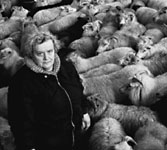
The sight took my breath away. Some of the riders had three horses
reined in beside them, so that each horse could have an opportunity
to rest. More riders, both men and women, waited to herd the sheep
down the trail to the corral. The sheep didn't want to cross a
rapidly running river and made frenzied figure eights on the mountainside.
Again I held my breath in wonder as they were finally ambushed,
with one farmer carrying the last headstrong animal across the
river over his shoulder like a small child.
When the sheep were gathered, we all headed for the large fenced area where they would be penned overnight. The riders were relaxed, quaffing down Icelandic vodka or a strong brandy known as Black Death. Our roundup guide, Kristjan, said that farmers make Black Death from sugar and alcohol, fermenting it for just six days before drinking it. Reporters and guests covering the event suddenly felt very fragile as they finally understood what the name of the drink truly meant.
The next morning the farmers and their families came to sort out their sheep at the round stone corral named Priveratt, or in English, the sheepfold. One hundred sheep at a time were moved from the fenced area into the corral which was divided into pie-shaped, numbered sections. Each sheep, identified by a brand on its ear, was led to the corresponding section of the corral. When the last of the sheep were sorted, each farmer loaded his own herd onto a truck and headed for the farm. This roundup has gone on, unchanged, for hundreds of years.
There can be problems for the sheep, even on the lowlands, in the severe winters. Kristjan told me of a time when 100 sheep were buried in a snowdrift. "Everyone came to help with aluminum poles and dogs. We used poles to find the sheep, but it was really the dogs who did the best work. We found 70 of them. One was not found for three weeks, but he was still alive."
The Icelandic sheep are well dressed for winter with a coarse outer layer coat, the tog, and a soft, downy undercoat, the pel, which provides insulation. This is why the Lopi is so light-weight, waterproof, and warm.
"We live by sheep," Peter Gierson, owner of a local hotel, told me. "A sheep stealer is close to a murderer in Iceland." Icelandic people know the value of their herds. Sheep provide food, clothing, and a living for many farmers here, and life on this island would be impossible without them.
I'm possessed by a malady known as Iceland fever. The island is a special-effects movie with an unlimited budget. Volcanoes spew out of glaciers. Steam hisses, and geysers spurt out of the ground. Rain and wind come in every direction, except up. Continental plates bump and grind along the Atlantic Ridge through the center of the country causing fissures and volcanic eruptions. But the landscape is only the whipped cream; the people take the cake. Here are 250,000 inhabitants living in the most hostile environment possible, but they enjoy universal education with a 98 percent literacy rate; the oldest parliamentary government; women who run the country; no poverty and no conspicuous wealth; no pollution; and geothermal heating for all. The residents have a dry wit, love ballroom dancing, are good with computers, and call everyone by their first names, including their president. In fact, they are listed by their first names in the phone directory--a great leveler.
I'd like to go back to Iceland in the winter, when the moonlight gleams on the snow and the roads are blown shut. I would sit snugly in the tea room of the elegant Hotel Borg in Reykjavik, eating Icelandic pastries, and staring out the window.
I want to visit in midsummer when the sun is a red ball of fire low in the sky.
I want to lie on my back in a swimming pool and gaze at the sky.
There can never be enough of Iceland for me.
--Bette McDevitt is a freelance travel writer who lives in New Castle, Pennsylvania.